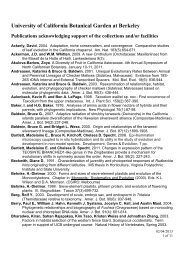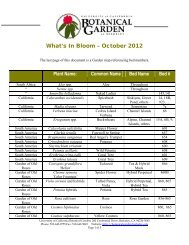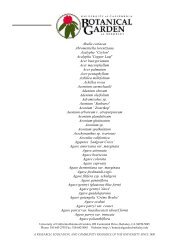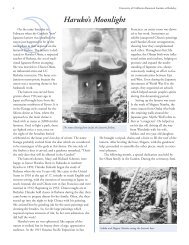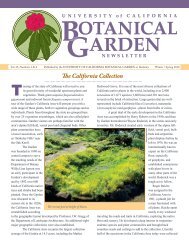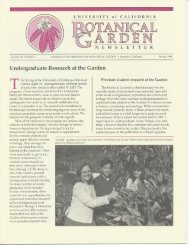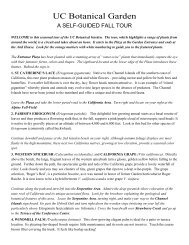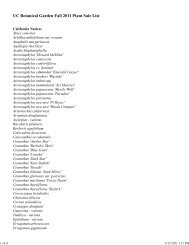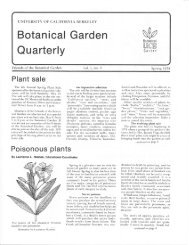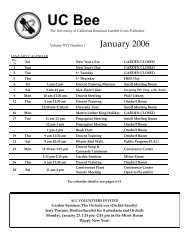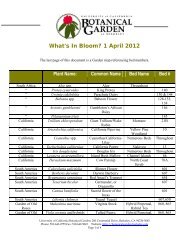Chinese Medicinal Herb Garden - University of California Botanical ...
Chinese Medicinal Herb Garden - University of California Botanical ...
Chinese Medicinal Herb Garden - University of California Botanical ...
You also want an ePaper? Increase the reach of your titles
YUMPU automatically turns print PDFs into web optimized ePapers that Google loves.
8. <strong>Herb</strong>s for Regulating Qi – <strong>Herb</strong>s for regulating<br />
Qi are used in <strong>Chinese</strong> traditional medicine primarily<br />
for pain in the chest and the abdomen. There are<br />
three major types <strong>of</strong> stagnant Qi: 1) Stagnant Spleen<br />
and Stomach Qi manifested as abdominal pain,<br />
belching and gas; 2) Stagnant Liver Qi manifested<br />
as depression, irritability or irregular or painful<br />
menstruation; 3) Stagnant Lung Qi leading to wheezing<br />
cough and constriction in the chest.<br />
9. <strong>Herb</strong>s for Regulating Blood – <strong>Herb</strong>s used to<br />
regulate the blood are divided into three categories:<br />
1) those that stop bleeding or hemorrhage – used<br />
for nose bleeds, blood in the stool or urine, excess<br />
menstrual blood or bleeding from trauma; 2) those<br />
taken to invigorate the blood – used when the flow<br />
<strong>of</strong> blood is blocked or static, causing localized pain or<br />
blood clots; 3) those that tonify the blood.<br />
10. Tonifying and Nurturing <strong>Herb</strong>s – These herbs<br />
are taken to strengthen an area or process <strong>of</strong> the body<br />
that is insufficient or weak. They also are regarded<br />
as effective in strengthening the body’s defenses<br />
against disease. Four deficiency patterns recognized in<br />
traditional <strong>Chinese</strong> medicine are: 1) Deficient Qi – with<br />
symptoms <strong>of</strong> fatigue, spontaneous sweating, weak<br />
voice, shallow breathing, lack <strong>of</strong> appetite. 2) Deficient<br />
Blood – with symptoms <strong>of</strong> pale face, dizziness,<br />
palpitations, dry skin, menstrual irregularities. 3)<br />
Deficient Yang – these herbs are used especially<br />
to tonify the kidney yang or the endocrine system,<br />
regulate the adrenal cortex, energy metabolism,<br />
strengthen resistance to disease and promote sexual<br />
function. 4) Deficient Yin – for symptoms <strong>of</strong> dryness,<br />
thirst, constipation, low grade sensation <strong>of</strong> heat, night<br />
sweats. <strong>Herb</strong>s are used to nourish and moisten by<br />
regulating fluid metabolism, including lowering blood<br />
pressure and serum cholesterol.<br />
11. Astringent <strong>Herb</strong>s – These herbs are used<br />
primarily for treating disorders in which bodily<br />
substances are discharged abnormally or structures slip<br />
from their proper positions. These include diarrhea,<br />
excessive urination or sweating, or prolapse <strong>of</strong> uterus<br />
or rectum. Such problems are usually due to weakness<br />
from chronic disease or old age.<br />
12. <strong>Herb</strong>s for Pacifying the Spirit – These herbs<br />
are used for disturbances <strong>of</strong> the Heart Spirit, with<br />
symptoms <strong>of</strong> irritability, palpitations and insomnia.<br />
These substances have sedative and tranquilizing<br />
effects.<br />
13. Fragrant <strong>Herb</strong>s for Opening Orifices –<br />
not represented in this collection.<br />
14. <strong>Herb</strong>s for Dissolving Phlegm and Relieving<br />
Cough – In <strong>Chinese</strong> medicine, phlegm is the<br />
pathological accumulation <strong>of</strong> thick fluid in the<br />
respiratory and digestive tracts, as well as in the<br />
muscles and other body tissue. Symptoms include<br />
coughing, wheezing, chest constriction, nausea,<br />
vomiting, loss <strong>of</strong> appetite, goiter and chronic lymph<br />
conditions.<br />
15. <strong>Herb</strong>s for Removing Congestion –These herbs<br />
are ingested to dissolve away, digest and reduce<br />
food stagnation out <strong>of</strong> the body via the digestive<br />
tract. They are useful for symptoms <strong>of</strong> nausea and<br />
abdominal distension/pain. Biochemically, these herbs<br />
increase digestive secretions and increase peristalsis or<br />
muscular contraction for better digestion.<br />
16. Parasiticides (Destroying Parasites) – These<br />
are used for intestinal parasites. They are neither as<br />
strong as many <strong>of</strong> the modern anti-parasitic drugs nor<br />
as rapid in action but they are significantly less toxic<br />
and some <strong>of</strong> the herbs also strengthen the spleen to<br />
help in digestion.<br />
17. External Uses – not represented in this collection.<br />
18. Anti-cancer <strong>Herb</strong>s – These herbs do not propose<br />
to cure cancer, but many <strong>of</strong> them are applied to<br />
alleviate pain and prolong life by strengthening the<br />
body’s life forces and arresting the progression <strong>of</strong><br />
tumors.<br />
The herbs are displayed for viewing only.<br />
DO NOT INGEST ANY PART OF ANY<br />
PLANT IN THIS GARDEN.<br />
REFERENCES AND FURTHER READING<br />
<strong>Chinese</strong> <strong>Herb</strong>al Medicine: Materia Medica, Third<br />
Edition. Compiled and translated by Dan Bensky,<br />
Steven Clavey, and Erich Stöger with Andrew Gamble.<br />
Eastland Press: Seattle, WA 2003.<br />
The <strong>Chinese</strong> <strong>Medicinal</strong> <strong>Herb</strong>al Farm: A Cultivator’s<br />
Guide to Small-Scale Organic <strong>Herb</strong> Production.<br />
Peg Schafer. Chelsea Green Publishing: White River<br />
Junction, VT 2011.<br />
ACKNOWLEDGEMENTS<br />
The <strong>Chinese</strong> <strong>Medicinal</strong> <strong>Herb</strong> <strong>Garden</strong> <strong>of</strong> the UC<br />
<strong>Botanical</strong> <strong>Garden</strong> is supported by the Chern<br />
Endowment in honor <strong>of</strong> Shih Nign Chern.<br />
<strong>Garden</strong> labels were prepared by Pr<strong>of</strong>essor Xu Honghua,<br />
with the assistance <strong>of</strong> the American College<br />
<strong>of</strong> Traditional <strong>Chinese</strong> Medicine (San Francisco),<br />
horticulturist Elaine Sedlack, calligrapher Feng-En<br />
Sung, acupuncturist Barbara Wilt, <strong>Chinese</strong> herbalist<br />
and acupuncturist Jeff Lee, and acupuncturist Rebecca<br />
Rapaport Ness, L. Ac. Linda Cook helped design both<br />
the labels and the original brochure.<br />
This brochure was written by Stephanie Kaza and Elaine<br />
Sedlack and edited by Carol Baird. It is also available in<br />
<strong>Chinese</strong>, translated by Kyle Young.<br />
Cover Illustration is a reproduction <strong>of</strong> a hanging scroll<br />
created by Miao Jiahui entitled Bouquet <strong>of</strong> Peonies.<br />
Michael Sullivan Private Collection, Oxford, England.<br />
Featured in Views from Jade Terrace: <strong>Chinese</strong> Women<br />
Artists 1300-1912, a publication <strong>of</strong> The Indianapolis<br />
Museum <strong>of</strong> Art.<br />
2012 © UC <strong>Botanical</strong> <strong>Garden</strong> at Berkeley<br />
The<br />
<strong>Chinese</strong><br />
<strong>Medicinal</strong> <strong>Herb</strong><br />
<strong>Garden</strong>
This stone acknowledges the joint sponsors <strong>of</strong><br />
the <strong>Chinese</strong> <strong>Medicinal</strong> <strong>Herb</strong> <strong>Garden</strong> – the left<br />
side translates that the stone is a gift from the<br />
People’s Republic <strong>of</strong> China in 1986 with calligraphy by<br />
Mr. Shang Cheng Zuo; the right side lists the three<br />
colleges involved. The center characters mean <strong>Garden</strong><br />
<strong>of</strong> <strong>Chinese</strong> <strong>Medicinal</strong> <strong>Herb</strong>s.<br />
THE CHINESE MEDICINAL HERB GARDEN<br />
is a special collection <strong>of</strong> over 100 herbs used in<br />
the practice <strong>of</strong> traditional <strong>Chinese</strong> medicine.<br />
The garden was developed in 1986 as a cooperative<br />
effort between the Guangzhou College <strong>of</strong> Traditional<br />
<strong>Chinese</strong> Medicine (now called Guangzhou <strong>University</strong> <strong>of</strong><br />
<strong>Chinese</strong> Medicine) in Guangdong Province, China, the<br />
American College <strong>of</strong> Traditional <strong>Chinese</strong> Medicine in<br />
San Francisco and the UC <strong>Botanical</strong> <strong>Garden</strong> at<br />
Berkeley. In 1987, Pr<strong>of</strong>essor Xu Hong-hua <strong>of</strong> the<br />
Guangzhou College spent six months in Berkeley<br />
designing the garden and supervising its installation.<br />
<strong>Medicinal</strong> herb gardens are common at medical<br />
colleges in China, but this collection is the only US<br />
medicinal garden arranged by function group.<br />
CHINESE MEDICINAL PHILOSOPHY<br />
Traditional <strong>Chinese</strong> medicine is one <strong>of</strong> the<br />
world’s oldest and most comprehensive systems <strong>of</strong><br />
medical care. <strong>Chinese</strong> medical philosophy<br />
is based on the Taoist principle <strong>of</strong> the<br />
interdependence <strong>of</strong> yin and yang, qualities<br />
that reflect all aspects <strong>of</strong> change and<br />
relationship in the universe. Some qualities <strong>of</strong> yang<br />
are: light, expanding, external, active, warm. Some<br />
qualities <strong>of</strong> yin are: darkness, contracting, internal,<br />
rest, cold. Illness is understood to occur when these<br />
elements are out <strong>of</strong> balance. Treatment is directed at<br />
restoring balance, which is equated with health.<br />
Six external pathogenic factors are recognized:<br />
cold, wind, damp, dryness, heat and summer heat<br />
(summer heat refers to illnesses that only occur in<br />
the summer, such as sunstroke). Treatment <strong>of</strong> these<br />
pathogenic effects is along channels or meridians,<br />
interchangeable terms that do not correspond to<br />
Western medical physiology. For example, there are<br />
yin and yang channels, kidney, liver, heart, lung, spleen<br />
and small intestine meridians, among others. There<br />
are twelve main channels, the points <strong>of</strong> which are used<br />
in acupuncture.<br />
<strong>Chinese</strong> physicians diagnose health conditions<br />
in terms <strong>of</strong> the quality <strong>of</strong> Qi (or Chi), an internal<br />
and external vital energy, and Blood. Qi and Blood<br />
are understood to move through the body via the<br />
channels, and it is when these channels are blocked<br />
that pain and illness occur. When the internal function<br />
<strong>of</strong> the organ becomes damaged, treatment can restore<br />
health by strengthening the weak areas.<br />
THE HERBS<br />
A <strong>Chinese</strong> prescription will contain 9-15 herbs<br />
(animal and mineral substances are used as well).<br />
Dried herb formulas are created as needed to be boiled<br />
into teas. Side effects common to Western medicine<br />
are largely eliminated in <strong>Chinese</strong> traditional medicine<br />
due to the fact that the prescription itself is balanced<br />
holistically.<br />
<br />
<strong>Chinese</strong><br />
medicine<br />
name<br />
bò hé<br />
Transliteration<br />
AS YOU WALK through this area, you will see individual<br />
plant labels and posts with signs marking the different<br />
function groups. The herbs are grouped according to<br />
function as described in traditional <strong>Chinese</strong> medical<br />
practice.<br />
FUNCTION GROUPS<br />
1. Surface Relieving <strong>Herb</strong>s – In traditional <strong>Chinese</strong><br />
medicine these herbs are applied to help conditions in<br />
the superficial levels <strong>of</strong> the body. Symptoms are chills,<br />
fever, headache, stiff neck, muscle aches, sweating,<br />
or the absence <strong>of</strong> appropriate sweating. Most <strong>of</strong> the<br />
herbs are diaphoretics (sweat inducers) believed to<br />
help the body release pathogenic influences through<br />
sweating.<br />
2. Purging <strong>Herb</strong>s – <strong>Chinese</strong> traditional medicine<br />
esteems these herbs that either stimulate or lubricate<br />
the gastrointestinal tract to facilitate excretion. Some<br />
have an antibiotic function and also help the body<br />
expel toxins. Others help when there is a weak<br />
peristalsis or muscular contraction in the intestines.<br />
3. Clearing Heat <strong>Herb</strong>s – Heat in traditional <strong>Chinese</strong><br />
medicine refers to fever conditions, and also to<br />
conditions that present heat signs including dry throat,<br />
Symbols for plant parts<br />
Surface Relieving<br />
MINT<br />
Mentha haplocalyx<br />
(Lamiaceae)<br />
fever, headache, rashes,<br />
sore throat<br />
Function group<br />
Scientific name<br />
Symtoms<br />
Plant part<br />
red face, red eyes, dry stool, dark scanty urine and rapid<br />
pulse. These herbs treat interior heat and are generally<br />
cold in nature. They have antipyretic, anti-inflammatory<br />
and antimicrobial effects.<br />
4. <strong>Herb</strong>s for Promoting the Flow <strong>of</strong> Water –<br />
These herbs increase urine production (i.e. are primarily<br />
diuretics). They are used for edema, strengthening fluid<br />
metabolism, urinary tract infections, purulent rashes<br />
and jaundice.<br />
5. <strong>Herb</strong>s for Eliminating Wind and Damp –<br />
These herbs are applied to promote analgesic, antiinflammatory,<br />
antipyretic and circulation-promoting<br />
effects. Wind and damp conditions in the muscles,<br />
joints, bones and sinews can block circulation, creating<br />
pain and numbness.<br />
6. <strong>Herb</strong>s for Warming Interior and Eliminating Cold<br />
<strong>Herb</strong>s used to warm the interior are cardiotonics that<br />
stimulate the vasoactive centers <strong>of</strong> the central nervous<br />
system to stimulate blood flow. They are believed to<br />
benefit digestion, increase absorption in the intestinal<br />
tract and alleviate vomiting and diarrhea. Symptoms<br />
indicating their use include cold extremities, slow pulse,<br />
fear <strong>of</strong> cold and pallid complexion.<br />
7. Fragrant <strong>Herb</strong>s for Dissolving Wetness –<br />
Excess wetness or dampness in traditional <strong>Chinese</strong><br />
medicine creates conditions <strong>of</strong> nausea, fullness in the<br />
abdomen, loss <strong>of</strong> appetite, lack <strong>of</strong> thirst, diarrhea,<br />
greasy coating on the tongue and headache. From<br />
a Western medical point <strong>of</strong> view, these conditions<br />
are usually caused by food poisoning or other acute<br />
digestive disorders. Most <strong>of</strong> the herbs are acrid,<br />
warming and drying.<br />
seed stem bark root fruit flower leaf whole plant




